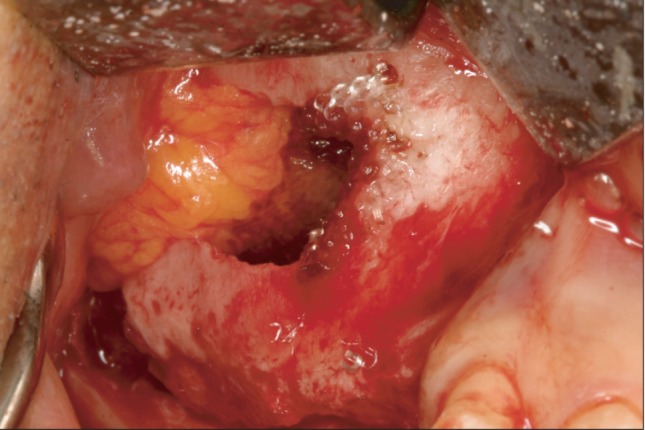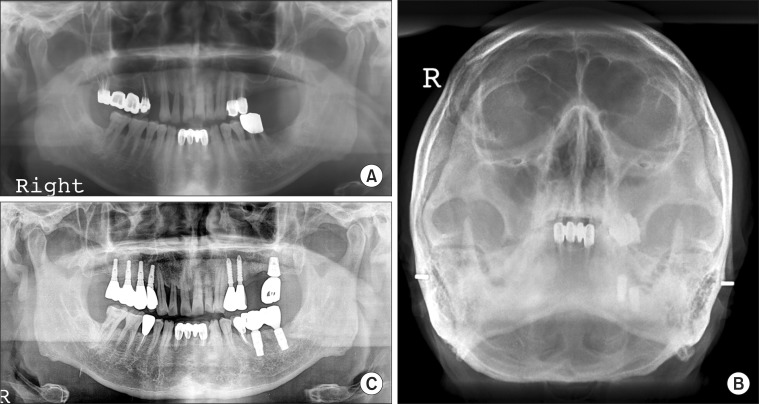J Korean Assoc Oral Maxillofac Surg.
2014 Aug;40(4):188-194. 10.5125/jkaoms.2014.40.4.188.
Prognosis of closure of large sinus membrane perforations using pedicled buccal fat pads and a resorbable collagen membrane: case series study
- Affiliations
-
- 1Department of Oral and Maxillofacial Surgery, Seoul National University Bundang Hospital, Section of Dentistry, Seoul National University, Seongnam, Korea.
- 2Department of Oral and Maxillofacial Surgery, School of Dentistry, Chosun University, Gwangju, Korea. sgckim@chosun.ac.kr
- KMID: 2005444
- DOI: http://doi.org/10.5125/jkaoms.2014.40.4.188
Abstract
- For large membrane perforations that develop during sinus-bone grafting, we performed repairs using a pedicled buccal fat pad and a resorbable collagen membrane simultaneously with the bone graft. This study included eight patients. Postoperative maxillary sinusitis developed in two patients, which we managed with incision and drainage, and antibiotics. Ultimately, six patients received 12 implants, three of which failed (75% success). Implant replacement was performed after the removal of the failed replacement, at which point the prosthetic treatment was considered complete. In all of the six cases that we were able to follow-up with, the sinus-bone graft was healing favorably. We observed that the sinus bone height decreased gradually with time. Based on these case series, we conclude that our procedure of repairing large sinus-membrane perforations with a pedicled buccal fat pad and a collagen membrane is a reliable technique.
MeSH Terms
Figure
Reference
-
1. Pikos MA. Maxillary sinus membrane repair: report of a technique for large perforations. Implant Dent. 1999; 8:29–34. PMID: 10356454.2. Kim YK, Choe GY, Yun PY. Management of perforated sinus membrane using absorbable hemostat and fibrin adhesive for sinus lift procedure. Asian J Oral Maxillofac Surg. 2008; 20:129–134.3. Testori T, Wallace SS, Del Fabbro M, Taschieri S, Trisi P, Capelli M, et al. Repair of large sinus membrane perforations using stabilized collagen barrier membranes: surgical techniques with histologic and radiographic evidence of success. Int J Periodontics Restorative Dent. 2008; 28:9–17. PMID: 18351198.4. Kim YK, Yi YJ, Yun PY, Yeo IS, Lee HJ, Kim SG, et al. All about implants in Q&A. Yongin: Quint Korea;2010. p. 300–307.5. Proussaefs P, Lozada J. The "Loma Linda pouch": a technique for repairing the perforated sinus membrane. Int J Periodontics Restorative Dent. 2003; 23:593–597. PMID: 14703763.6. Kim YK, Hwang JW, Yun PY. Closure of large perforation of sinus membrane using pedicled buccal fat pad graft: a case report. Int J Oral Maxillofac Implants. 2008; 23:1139–1142. PMID: 19216286.7. Krennmair G, Ulm C, Lugmayr H. Maxillary sinus septa: incidence, morphology and clinical implications. J Craniomaxillofac Surg. 1997; 25:261–265. PMID: 9368861.
Article8. Peleg M, Mazor Z, Chaushu G, Garg AK. Sinus floor augmentation with simultaneous implant placement in the severely atrophic maxilla. J Periodontol. 1998; 69:1397–1403. PMID: 9926770.
Article9. Kasabah S, Krug J, Simůnek A, Lecaro MC. Can we predict maxillary sinus mucosa perforation? Acta Medica (Hradec Kralove). 2003; 46:19–23. PMID: 12747535.
Article10. Ardekian L, Oved-Peleg E, Mactei EE, Peled M. The clinical significance of sinus membrane perforation during augmentation of the maxillary sinus. J Oral Maxillofac Surg. 2006; 64:277–282. PMID: 16413901.
Article11. Betts NJ, Miloro M. Modification of the sinus lift procedure for septa in the maxillary antrum. J Oral Maxillofac Surg. 1994; 52:332–333. PMID: 8308638.
Article12. Cho SC, Wallace SS, Froum SJ, Tarnow DP. Influence of anatomy on Schneiderian membrane perforations during sinus elevation surgery: three-dimensional analysis. Pract Proced Aesthet Dent. 2001; 13:160–163. PMID: 11315435.13. Ulm CW, Solar P, Krennmair G, Matejka M, Watzek G. Incidence and suggested surgical management of septa in sinus-lift procedures. Int J Oral Maxillofac Implants. 1995; 10:462–465. PMID: 7672849.14. van den Bergh JP, ten Bruggenkate CM, Disch FJ, Tuinzing DB. Anatomical aspects of sinus floor elevations. Clin Oral Implants Res. 2000; 11:256–265. PMID: 11168217.
Article15. Thorn JJ, Sørensen H, Weis-Fogh U, Andersen M. Autologous fibrin glue with growth factors in reconstructive maxillofacial surgery. Int J Oral Maxillofac Surg. 2004; 33:95–100. PMID: 14690664.
Article16. van den Bergh JP, ten Bruggenkate CM, Krekeler G, Tuinzing DB. Maxillary sinusfloor elevation and grafting with human demineralized freeze dried bone. Clin Oral Implants Res. 2000; 11:487–493. PMID: 11168241.
Article17. Hernández-Alfaro F, Torradeflot MM, Marti C. Prevalence and management of Schneiderian membrane perforations during sinus-lift procedures. Clin Oral Implants Res. 2008; 19:91–98. PMID: 17961185.
Article18. Jensen J, Sindet-Pedersen S, Oliver AJ. Varying treatment strategies for reconstruction of maxillary atrophy with implants: results in 98 patients. J Oral Maxillofac Surg. 1994; 52:210–216. PMID: 8308618.
Article19. Karabuda C, Arisan V, Özyuvaci H. Effects of sinus membrane perforations on the success of dental implants placed in the augmented sinus. J Periodontol. 2006; 77:1991–1997. PMID: 17209783.
Article20. Proussaefs P, Lozada J, Kim J. Effects of sealing the perforated sinus membrane with a resorbable collagen membrane: a pilot study in humans. J Oral Implantol. 2003; 29:235–241. PMID: 14620686.
Article21. Proussaefs P, Lozada J, Kim J, Rohrer MD. Repair of the perforated sinus membrane with a resorbable collagen membrane: a human study. Int J Oral Maxillofac Implants. 2004; 19:413–420. PMID: 15214227.22. Schwartz-Arad D, Herzberg R, Dolev E. The prevalence of surgical complications of the sinus graft procedure and their impact on implant survival. J Periodontol. 2004; 75:511–516. PMID: 15152813.
Article23. Egyedi P. Utilization of the buccal fat pad for closure of oro-antral and/or oro-nasal communications. J Maxillofac Surg. 1977; 5:241–244. PMID: 338848.
Article24. Neder A. Use of buccal fat pad for grafts. Oral Surg Oral Med Oral Pathol. 1983; 55:349–350. PMID: 6574411.
Article
- Full Text Links
- Actions
-
Cited
- CITED
-
- Close
- Share
- Similar articles
-
- Techniques for Reparation of Perforations of the Maxillary Sinus Membrane: Article Review
- Clinical Evaluation of the effectiveness of pedicled buccal fat pad grafts in closure of oroantral communications
- Intra-sinus rigid fixation of a resorbable barrier membrane to repair a large perforation of the sinus membrane: a technical note
- Palatal fistula closure with lengthening of soft palate using a pedicled buccal fat and a buccinator flap: a case report
- The use of buccal fat pad as a pedicled graft for the reconstruction of oral mucosal defect







